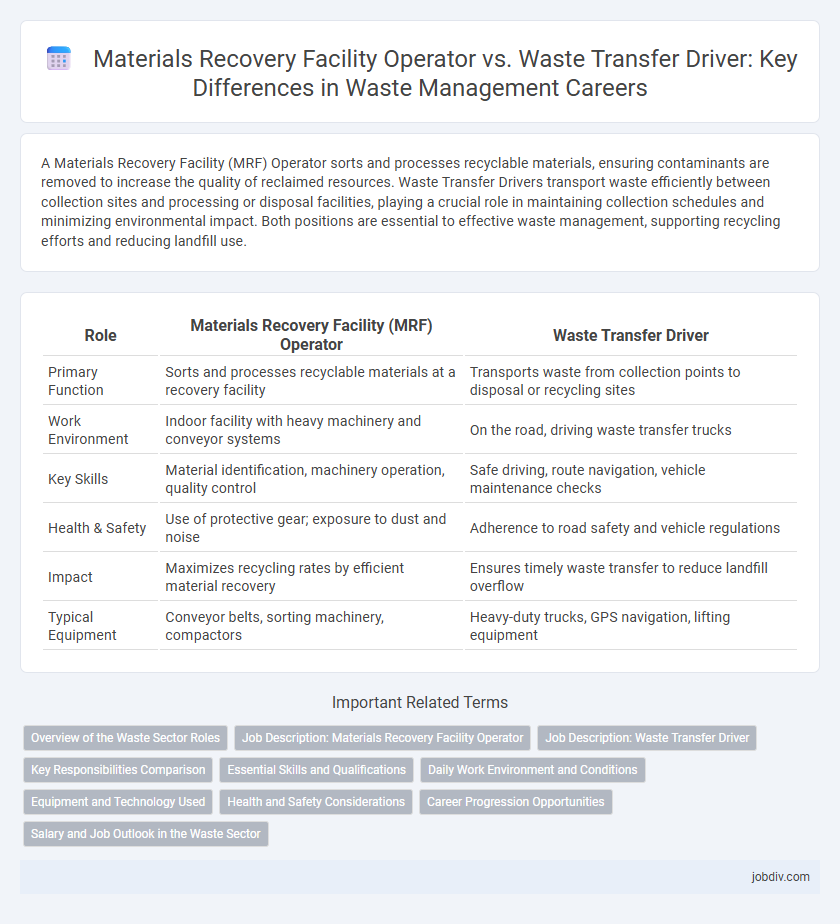A Materials Recovery Facility (MRF) Operator sorts and processes recyclable materials, ensuring contaminants are removed to increase the quality of reclaimed resources. Waste Transfer Drivers transport waste efficiently between collection sites and processing or disposal facilities, playing a crucial role in maintaining collection schedules and minimizing environmental impact. Both positions are essential to effective waste management, supporting recycling efforts and reducing landfill use.
Table of Comparison
| Role | Materials Recovery Facility (MRF) Operator | Waste Transfer Driver |
|---|---|---|
| Primary Function | Sorts and processes recyclable materials at a recovery facility | Transports waste from collection points to disposal or recycling sites |
| Work Environment | Indoor facility with heavy machinery and conveyor systems | On the road, driving waste transfer trucks |
| Key Skills | Material identification, machinery operation, quality control | Safe driving, route navigation, vehicle maintenance checks |
| Health & Safety | Use of protective gear; exposure to dust and noise | Adherence to road safety and vehicle regulations |
| Impact | Maximizes recycling rates by efficient material recovery | Ensures timely waste transfer to reduce landfill overflow |
| Typical Equipment | Conveyor belts, sorting machinery, compactors | Heavy-duty trucks, GPS navigation, lifting equipment |
Overview of the Waste Sector Roles
Materials Recovery Facility (MRF) Operators manage the processing and sorting of recyclable materials to ensure effective recovery and minimal contamination, utilizing advanced sorting technologies and quality control measures. Waste Transfer Drivers transport collected waste from local collection points to transfer stations or disposal facilities, ensuring timely and safe handling of materials to optimize waste logistics. Both roles are integral to the waste management supply chain, enhancing recycling rates and operational efficiency within the waste sector.
Job Description: Materials Recovery Facility Operator
Materials Recovery Facility Operators manage the sorting and processing of recyclable materials at waste management sites, ensuring efficient recovery and minimal landfill use. They operate heavy machinery, inspect incoming waste streams, and monitor equipment performance to separate metals, plastics, and paper for recycling. This role demands knowledge of safety protocols, material identification, and maintenance of facility operations to optimize recycling outputs.
Job Description: Waste Transfer Driver
A Waste Transfer Driver is responsible for transporting collected waste from local collection points to designated materials recovery facilities (MRFs) or disposal sites, ensuring efficient and timely delivery. They operate heavy-duty vehicles while adhering to safety regulations, managing load weights, and maintaining logs for compliance and tracking purposes. This role requires knowledge of waste handling protocols and coordination with MRF operators to optimize waste sorting and processing workflows.
Key Responsibilities Comparison
Materials Recovery Facility Operators manage sorting, processing, and separating recyclable materials to ensure quality control and optimize recovery rates in recycling plants. Waste Transfer Drivers are responsible for transporting waste from collection points to disposal sites or recycling centers, maintaining safety protocols, and ensuring timely delivery. Both roles are critical in waste management systems, with operators focused on material processing and drivers on logistics and transportation efficiency.
Essential Skills and Qualifications
Materials Recovery Facility Operators require expertise in sorting recyclable materials, operating heavy machinery, and adhering to safety protocols, with qualifications often including a high school diploma and specialized training in waste management. Waste Transfer Drivers need a commercial driver's license (CDL), knowledge of waste handling regulations, and skill in vehicle maintenance and route navigation. Both roles demand strong attention to detail, physical stamina, and commitment to environmental compliance standards.
Daily Work Environment and Conditions
Materials Recovery Facility Operators work primarily indoors in noisy, fast-paced environments sorting recyclable materials, often exposed to dust and debris with protective gear required for safety. Waste Transfer Drivers spend most of their day driving heavy vehicles between collection points and disposal sites, facing variable weather conditions and long hours on the road. Both roles demand physical stamina and adherence to strict safety protocols to manage risks associated with waste handling and transportation.
Equipment and Technology Used
Materials Recovery Facility Operators utilize advanced sorting technologies such as automated conveyor belts, optical sorters, and magnetic separators to efficiently segregate recyclable materials. Waste Transfer Drivers operate heavy-duty trucks equipped with compactors and hydraulic lifts to transport waste between collection points and processing facilities. Both roles leverage GPS tracking and communication systems to optimize route planning and facility coordination.
Health and Safety Considerations
Materials Recovery Facility Operators face heightened health risks due to prolonged exposure to airborne contaminants, sharp objects, and heavy machinery in sorting and processing waste materials. Waste Transfer Drivers encounter potential hazards during loading and unloading of waste, including ergonomic strain, traffic accidents, and exposure to hazardous substances in confined truck spaces. Both roles require stringent adherence to personal protective equipment (PPE) protocols and comprehensive safety training to mitigate occupational injuries and promote a safe working environment.
Career Progression Opportunities
Materials Recovery Facility Operators often advance to supervisory or management roles within recycling and waste processing centers due to their specialized knowledge in sorting technologies and operational procedures. Waste Transfer Drivers can progress toward logistics coordination or fleet management positions, leveraging their expertise in transportation routes and regulatory compliance. Both career paths offer opportunities for skill development and leadership in the evolving waste management industry.
Salary and Job Outlook in the Waste Sector
Materials Recovery Facility Operators earn an average salary of $35,000 to $50,000 annually, reflecting specialized skills in sorting and processing recyclables, while Waste Transfer Drivers typically make between $40,000 and $55,000 due to the demands of operating heavy vehicles and managing waste logistics. Job outlook for both positions remains stable, with a projected growth rate of 5-7% over the next decade driven by increasing emphasis on sustainable waste management and recycling programs. The waste sector's expansion highlights consistent demand for skilled operators and drivers, reinforcing competitive compensation tied to experience and regional waste processing needs.
Materials Recovery Facility Operator vs Waste Transfer Driver Infographic

 jobdiv.com
jobdiv.com